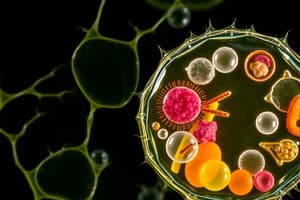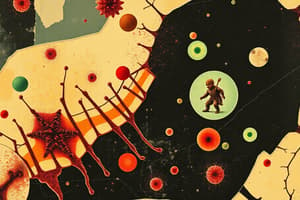Podcast
Questions and Answers
What is the primary function of mitochondria?
What is the primary function of mitochondria?
- Modify and package proteins
- Generate energy through cellular respiration (correct)
- Store genetic information
- Synthesize proteins
Which organelle is involved in detoxifying harmful substances?
Which organelle is involved in detoxifying harmful substances?
- Peroxisomes (correct)
- Ribosomes
- Golgi Apparatus
- Lysosomes
Which characteristic of life involves the uptake of nutrients into cells?
Which characteristic of life involves the uptake of nutrients into cells?
- Digestion
- Excretion
- Absorption (correct)
- Ingestion
What is the role of the Golgi Apparatus in a cell?
What is the role of the Golgi Apparatus in a cell?
Which muscle type is involuntary and found in the heart?
Which muscle type is involuntary and found in the heart?
How does the transverse plane divide the body?
How does the transverse plane divide the body?
Which process is responsible for the removal of waste products from the body?
Which process is responsible for the removal of waste products from the body?
What maintains the shape of the cell and facilitates movement within it?
What maintains the shape of the cell and facilitates movement within it?
What is the function of acetylcholinesterase in muscle contraction?
What is the function of acetylcholinesterase in muscle contraction?
During which period does the muscle actually contract after stimulation?
During which period does the muscle actually contract after stimulation?
What initiates the muscle contraction process?
What initiates the muscle contraction process?
What is the role of calcium in muscle contraction?
What is the role of calcium in muscle contraction?
Which enzyme hydrolyzes ATP to provide energy for the power stroke during muscle contraction?
Which enzyme hydrolyzes ATP to provide energy for the power stroke during muscle contraction?
What occurs during tetanic contraction?
What occurs during tetanic contraction?
What does the endomysium surround in skeletal muscle?
What does the endomysium surround in skeletal muscle?
What is the primary result of summation in muscle fibers?
What is the primary result of summation in muscle fibers?
What is the role of myosin in muscle contraction?
What is the role of myosin in muscle contraction?
Which type of muscle contraction occurs when a muscle changes length during contraction?
Which type of muscle contraction occurs when a muscle changes length during contraction?
What distinguishes smooth muscle from skeletal muscle?
What distinguishes smooth muscle from skeletal muscle?
What is the primary role of agonist muscles during contraction?
What is the primary role of agonist muscles during contraction?
How does a motor unit impact muscle contraction strength?
How does a motor unit impact muscle contraction strength?
What is the function of acetylcholine in the muscle contraction process?
What is the function of acetylcholine in the muscle contraction process?
In anatomical terms, what is typically meant by the origin of a muscle?
In anatomical terms, what is typically meant by the origin of a muscle?
What are calcium ions and ATP essential for in muscle contraction?
What are calcium ions and ATP essential for in muscle contraction?
Flashcards
Organelle
Organelle
A specialized structure within a cell that performs a specific function. Think of it as a tiny organ within a cell.
Nucleus
Nucleus
The cell's control center. It stores genetic information (DNA) and directs cell activities like growth and protein production.
Mitochondria
Mitochondria
The powerhouse of the cell. It generates energy (ATP) through cellular respiration.
Ribosomes
Ribosomes
Signup and view all the flashcards
Endoplasmic Reticulum (ER)
Endoplasmic Reticulum (ER)
Signup and view all the flashcards
Golgi Apparatus
Golgi Apparatus
Signup and view all the flashcards
Lysosomes
Lysosomes
Signup and view all the flashcards
Homeostasis
Homeostasis
Signup and view all the flashcards
Summation
Summation
Signup and view all the flashcards
Epimysium
Epimysium
Signup and view all the flashcards
Perimysium
Perimysium
Signup and view all the flashcards
Endomysium
Endomysium
Signup and view all the flashcards
Latent period
Latent period
Signup and view all the flashcards
Contraction period
Contraction period
Signup and view all the flashcards
Relaxation period
Relaxation period
Signup and view all the flashcards
Cross-Bridging
Cross-Bridging
Signup and view all the flashcards
Smooth Muscle
Smooth Muscle
Signup and view all the flashcards
Motor Unit
Motor Unit
Signup and view all the flashcards
Isometric Contraction
Isometric Contraction
Signup and view all the flashcards
Isotonic Contraction
Isotonic Contraction
Signup and view all the flashcards
Agonist Muscle
Agonist Muscle
Signup and view all the flashcards
Antagonist Muscle
Antagonist Muscle
Signup and view all the flashcards
Motor Unit Recruitment
Motor Unit Recruitment
Signup and view all the flashcards
Origin of a Muscle
Origin of a Muscle
Signup and view all the flashcards
Study Notes
Organelles
- Organelles are specialized structures within cells performing specific functions
- Nucleus: Stores genetic information, controls cell activities (growth, metabolism, protein synthesis)
- Mitochondria: Generate energy (ATP) through cellular respiration
- Ribosomes: Synthesize proteins
- Endoplasmic Reticulum (ER): Transports proteins and materials; smooth ER synthesizes lipids; rough ER synthesizes proteins
- Golgi Apparatus: Modifies, sorts, and packages proteins for secretion or delivery
- Lysosomes: Break down waste materials and cellular debris
- Peroxisomes: Break down fatty acids and detoxify harmful substances
- Cytoskeleton: Maintains cell shape, facilitates movement within the cell
Characteristics of Life
- An organism is considered alive if it demonstrates these characteristics
- Metabolism: Chemical reactions (catabolic and anabolic) for life maintenance
- Reproduction: Ability to reproduce and pass on genetic material
- Circulation: Movement of substances (nutrients, gases, waste) throughout the organism
- Digestion: Breakdown of food into simpler molecules for absorption
- Ingestion: Taking in food and liquids
- Absorption: Uptake of nutrients into cells or tissues
- Excretion: Removal of waste products from the body
Other Important Concepts
- Homeostasis: Maintaining a stable internal environment despite external changes (temperature regulation, pH balance, blood sugar regulation)
Planes of the Body
- Transverse Plane: Divides the body into upper and lower parts
- Sagittal Plane: Divides the body into right and left halves
- Frontal (Coronal) Plane: Divides the body into front and back portions
Muscle Tissue
- Skeletal Muscle: Voluntary, striated muscle used for moving bones
- Cardiac Muscle: Involuntary, striated muscle found in the heart with intercalated discs
- Smooth Muscle: Involuntary, non-striated muscle in organ walls (intestines, blood vessels), responsible for involuntary movements like peristalsis
Skeletal Muscle Contractions
- Motor Unit: A motor neuron and all muscle fibers it controls (stronger contraction = more fibers)
- Types of Contractions:
- Isometric: Muscle contracts but doesn't change length
- Isotonic: Muscle changes length during contraction (concentric - shortening, eccentric - lengthening)
- Motor Unit Definition: Functional unit of muscle contraction, consisting of a single motor neuron and the muscle fibers it innervates
- Neurological and Physiological Components: Motor neurons transmit signals from the central nervous system to muscle fibers triggering muscle contraction
Muscle Movement
- Myofibril: Long, threadlike structures within muscle fibers containing sarcomeres (contractile units)
- End Plate: Where a motor neuron connects with a muscle fiber (part of the neuromuscular junction)
- Motor Neuron: Transmits signals from the central nervous system to the muscle
- Actin & Myosin: Filaments within the sarcomere for muscle contraction (Myosin binds to Actin to move and create contractions)
- Chemicals: Acetylcholine, Calcium ions, and ATP are critical for muscle contraction
- Agonist: Prime mover in muscle contraction
- Antagonist: Muscle that opposes the agonist's action
- Recruitment: More motor units recruited to generate more force as load increases
- Origin: Fixed attachment point of a muscle to a bone
- Insertion: Movable attachment point of a muscle to a bone
Sarcomere
- Structure and Function: Smallest functional unit of muscle contraction, composed of actin and myosin filaments
- Summation: Repeated stimuli result in stronger contractions (potentially tetanic contraction)
Layers of Skeletal Muscle
- Epimysium: Outer layer surrounding the whole muscle
- Perimysium: Surrounds individual fascicles (bundles of muscle fibers)
- Endomysium: Surrounds individual muscle fibers
Periods of a Muscle Twitch
- Latent Period: Time between stimulus and contraction onset
- Contraction Period: Time during muscle contraction
- Relaxation Period: Time during muscle relaxation
Steps in Muscle Contraction
- Neural signal (action potential) activates the muscle
- Acetylcholine released, triggers action potential
- Calcium released from sarcoplasmic reticulum, exposes binding sites on actin
- Cross-bridge formation between myosin and actin
- Power stroke occurs, causing muscle contraction (myosin moves actin)
- Myosin heads detach, reattach for continued contraction (cross-bridge cycling)
- Muscle relaxes when neural signal stops, calcium pumped back into sarcoplasmic reticulum
Cross-Bridging
- Steps in cross-bridging (detailed steps of the molecular process of muscle contraction)
Enzymes in Muscle Contraction
- Acetylcholinesterase: Breaks down acetylcholine to stop stimulation
- Myosin ATPase: Hydrolyzes ATP for power stroke energy
- Creatine Kinase: Regenerates ATP during short bursts of activity
- Phosphofructokinase (PFK): Catalyzes glycolysis to produce ATP from glucose
- Myokinase: Converts ADP to ATP during intense exercise
- Calcium ATPase (SERCA): Pumps calcium back into the sarcoplasmic reticulum for muscle relaxation
- Troponin C: Binds calcium, initiates muscle contraction by exposing actin-myosin binding sites
Skeleton
- Skeletal Regeneration: Process of blood cell production (10 years)
- Hematopoiesis: Formation of blood cells in red bone marrow (red blood cells, white blood cells, platelets)
Studying That Suits You
Use AI to generate personalized quizzes and flashcards to suit your learning preferences.
Related Documents
Description
Explore the key cell organelles and their functions, along with the essential characteristics that define life. This quiz will test your knowledge about the different structures within cells and how they contribute to the maintenance of life processes.




